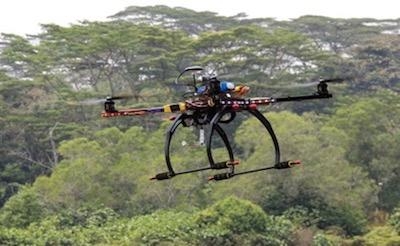Thu, Feb 22, 2018
Releases InFO Saying Drone Operators Should Be Easily Identified By The Public
In order to help bolster public awareness of sUAS operations and reduce the number of distractions for remote pilots and others participating in sUAS operations, the FAA recommends remote pilots in command, anyone operating the flight controls of the sUAS, visual observers, and any other person providing assistance in the sUAS operation wear brightly colored and reflective vests during flight operations.

In an Information For Operators (InFO) released by the agency, the FAA says the vest should have wording on the back identifying the individual as the remote pilot, visual observer, or other person involved in the sUAS operation. The vests should have wording such as “Drone Pilot Please Do Not Disturb”, “Drone Pilot Stand Clear”, “Drone Pilot”, “Designated Visual Observer” or similar for purposes of identification and to caution against distraction.
A vest as described above is easily distinguishable and often used by other safety-centric personnel such as construction and utility workers, airport ground crews, and railway personnel. The vest may reduce the likelihood someone will approach or query a person involved in sUAS operations.
While the use of highly visible reflective vests is intended to aid in the identification of sUAS remote pilots and others participating in sUAS operations and minimize the likelihood of distractions during such operation, their use does not negate the need to respond to requests from law enforcement in an urgent manner. Title 49 USC 44103(d) requires operators of aircraft (to include UAS) to make available for inspection a certificate of registration for the aircraft when requested by a United States Government, State, or local law enforcement officer. Operators must heed law enforcement requests for documentation and should abide by other requests from law enforcement officials.
The FAA recommends remote pilots and other persons participating in the sUAS operation wear brightly colored and reflective vests during such operation. The vest should have wording on the back identifying the individual as the remote pilot, visual observer, or other person participating in the sUAS operation and include a caution against distracting the person wearing such vest.
(Image from file)
More News
Also: B-29 Superfortress Reunion, FAA Wants Controllers, Spirit Airlines Pulls Back, Gogo Galileo Van's Aircraft posted a short video recapping the goings-on around their reorganiz>[...]
Light Gun A handheld directional light signaling device which emits a brilliant narrow beam of white, green, or red light as selected by the tower controller. The color and type of>[...]
"The journey to this achievement started nearly a decade ago when a freshly commissioned Gentry, driven by a fascination with new technologies and a desire to contribute significan>[...]
"Our driven and innovative team of military and civilian Airmen delivers combat power daily, ensuring our nation is ready today and tomorrow." Source: General Duke Richardson, AFMC>[...]
Aircraft Conflict Predicted conflict, within EDST of two aircraft, or between aircraft and airspace. A Red alert is used for conflicts when the predicted minimum separation is 5 na>[...]
 Airborne 04.16.24: RV Update, Affordable Flying Expo, Diamond Lil
Airborne 04.16.24: RV Update, Affordable Flying Expo, Diamond Lil ANN's Daily Aero-Term (04.20.24): Light Gun
ANN's Daily Aero-Term (04.20.24): Light Gun Aero-News: Quote of the Day (04.20.24)
Aero-News: Quote of the Day (04.20.24) Aero-News: Quote of the Day (04.21.24)
Aero-News: Quote of the Day (04.21.24) ANN's Daily Aero-Term (04.21.24): Aircraft Conflict
ANN's Daily Aero-Term (04.21.24): Aircraft Conflict



